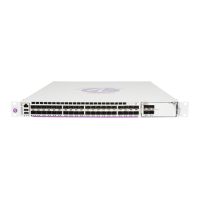Services Overview
7705 SAR OS Services Guide Page 49
Spoke SDPs
There are two types of SDPs: spoke and mesh. The type of SDP defines how flooded traffic
(or broadcast traffic, such as an ARP request) is transmitted. For point-to-point PW/VLL
services, spoke SDPs are the only way to bind services to the far-end router.
A spoke SDP that is bound to a service operates like a traditional bridge port. Flooded traffic
that is received on the spoke SDP is transmitted to all the spoke SDPs to which it is
connected. Flooded traffic is not transmitted back toward the port from which it was
received.
SDP Encapsulation Types
The Alcatel-Lucent service model uses encapsulation tunnels (also referred to as service
tunnels) through the core to interconnect 7705 SAR and SR routers. An SDP is a logical way
of referencing the entrance to an encapsulation tunnel.
In Release 3.0, the following encapsulation types are supported:
• Layer 2 within multiprotocol label switching (MPLS Encapsulation)
• Layer 2 or Layer 3 within generic routing encapsulation (GRE Encapsulation)
• Layer 2 within IP (IP Encapsulation)
Each SDP service tunnel has an entrance and an exit point for the pseudowires contained
within it.
MPLS Encapsulation
Multiprotocol label switching (MPLS) encapsulation has the following characteristics.
• An MPLS 7705 SAR router supports both signaled and non-signaled LSPs through
the network.
• Non-signaled paths are defined at each hop through the network.
An SDP has an implicit Maximum Transmission Unit (MTU) value because services are
carried in encapsulation tunnels and an SDP is an entrance to the tunnel. The MTU is
configurable (in octets), where the transmitted frame can be no larger than the MTU.
Note: In contrast, a mesh SDP that is bound to a service operates like a single bridge port.
Flooded traffic received on a mesh SDP is transmitted to all spoke SDPs and SAPs to which
it is connected. Flooded traffic is not transmitted to any other mesh SDPs or back toward the
port from which it was received. This property of mesh SDPs is important for multi-node
networks; mesh SDPs are used to prevent the creation of routing loops.

